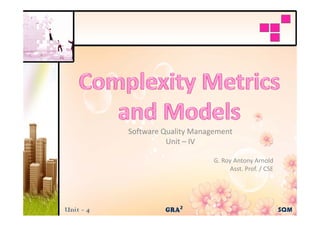
Complexity metrics and models
- 1. Software Quality Management Unit – IV G. Roy Antony Arnold Asst. Prof. / CSE
- 2. • The li h lines of code ( OC) count i usually f f d (LOC) is ll for executable statements. • LOC count represents the program size and complexity, it is not a surprise that . • More recent studies point to a curvilinear relationship between lines of code and defect rate:
- 4. Maximum Source Average Defect per Lines of Modules 1,000 Source Lines 63 1.5 100 1.4 158 0.9 251 0.5 398 1.1 630 1.9 1000 1.3 >1000 1.4
- 5. • Wh When module size b d l i becomes very l large, the h complexity increases to a level beyond a programmer s programmer's immediate span of control and total comprehension. • The curvilinear model between size and defect density sheds new light on software quality engineering. It implies that there may be an g g p y optimal program size that can lead to the lowest defect rate. • Such an optimum may depend on language, project, product, and environment; apparently many more empirical i i i l investigations are needed. ti ti d d
- 6. • Halstead (1977) distinguishes software science from computer science. • The premise of software science is that any programming task consists of selecting and arranging a finite number of program “tokens”, which are tokens . • A computer program, according to software di f science, .
- 7. • Th primitive measures of H l t d' software science The i iti f Halstead's ft i are • Based on these primitive measures, Halstead developed a system of equations expressing and other features such as development effort and the projected number of faults in the software.
- 9. • The measurement of cyclomatic complexity b h f l i l i by McCabe (1976) was designed (maintainability). • It is the classical graph theory cyclomatic number, . • To determine the paths, the program procedure is represented .
- 10. • The general formula to compute cyclomatic p y complexity is: • Wh Where, V(G) – Cyclomatic Number of G ( ) y e – Number of edges n – Number of nodes n Number of nodes p – Number of unconnected parts of the graph
- 11. • If we count the edges, nodes, and disconnected parts of the graph, • The iteration test in a looping statement is The iteration test in a looping statement is counted as one binary decision. In the preceding simple example, since there are two binary decisions, M = 2 + 1 = 3 • The cyclomatic complexity metric is additive. The complexity of several graphs additive The complexity of several graphs considered as a group is equal to the sum g p p of the individual graphs' complexities.
- 13. needing detailed inspections. g p likely to have a low defect rate and therefore have a low defect rate and therefore candidates for development without detailed inspections. l , identify troublesome code, and estimate testing effort. estimate testing effort
- 14. • McCabe's cyclomatic complexity index is a . • It does not distinguish different kinds of control flow complexity such as p y . • In studying the quality and syntactic indicators among a sample of twenty modules of a COBOL compiler product product, found that at the module level can be estimated through the following equations:
- 15. • Lo found that most developers were having difficulty p g y mastering the DO WHILE construct. • As a result, minimizing the use of DO WHILE was one of the actions the team took to reduce defects in the compiler product.
- 16. • St t Structure metrics try to take into account the ti t t t k i t t th . • The most common design structure metrics are the are the , which are which are based on the proposed by (1979) and (1978): A count of the modules that call a given module : A count of modules that are called by a given module given module
- 17. • I l d l ith l f i In general, modules with a large fan‐in are . • In contrast, modules that are large and complex are likely to have a small fan‐in. structure complexity is defined as: • Henry and Selig's work (1990) defines a hybrid form of their information‐flow metric as of their information flow metric as where, C internal complexity of procedure p where, Cip – internal complexity of procedure p
- 18. • C d d Gl (1990) d l Card and Glass (1990) developed a system complexity model d t l it d l Ct – System Complexity St – Structural (intermodule) System Complexity, S Structural (intermodule) complexity, Dt – Data (intermodule) complexity • They defined relative system complexity as n – no. Of modules in the system • S Structure complexity is further defined as l i i f h d fi d S= ∑ f 2 (i ) n Where S – Structural Complexity, f(i) – Fan‐out of Module i, n – no. Of modules in the system
- 19. • D t C Data Complexity is further defined as l it i f th d fi d Di Data Complexity of Module i, V(i) I/O Di – Data Complexity of Module i, V(i) – I/O Variables in module i, f(i) – fan‐out of module i D – Data (intramodule) Complexity, D(i) – Data Complexity of module i, n = Number of new modules in the system
